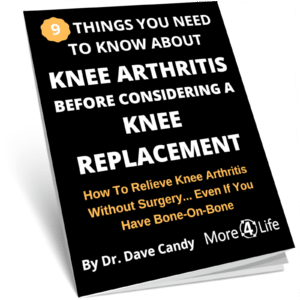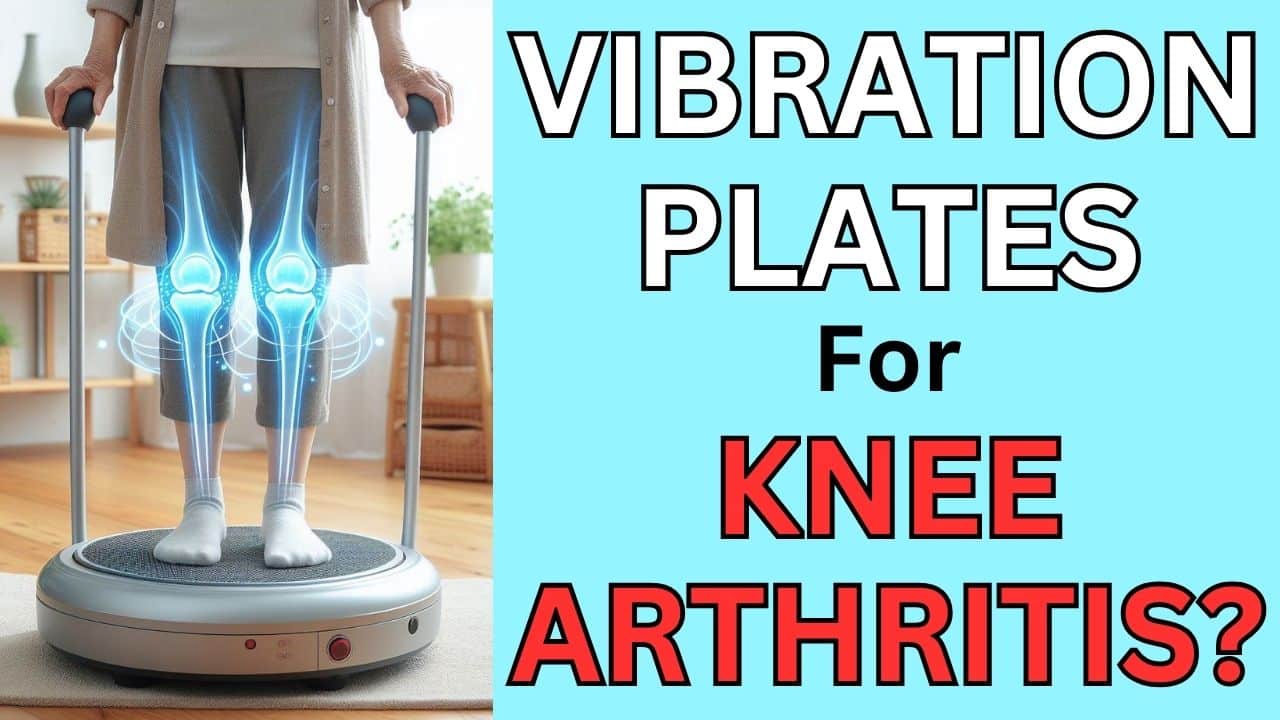Vibration plates are becoming increasingly popular in the fitness industry as well as on social media. Whole body vibration therapy has been touted to help with muscle strength, weight loss, bone density, and circulation.
But Are Vibration Plates Good For Knee Arthritis?
That's the question that I'll answer in this post. But don't take my word for it. The information in this post is backed by data from 14 randomized controlled trials studying the effect of whole body vibration therapy in people with knee osteoarthritis.
Table Of Contents
- What Are Vibration Plates?
- How Are Vibration Plates Supposed To Help Knee Arthritis?
- Are Vibration Plates Good For Knee Arthritis?
- How Effective Are Vibration Plates For Knee Arthritis?
- How To Use A Vibration Plate For Knee Arthritis
- What To Look For When Buying A Vibration Plate
- How Much Do Vibration Plates Cost?
- Conclusion
- What Other Treatments Are Good For Knee Arthritis?

What Are Vibration Plates?
Vibration plates are vibrating platforms that you stand on. They oscillate up and down and/or side to side and vibrate your body.
But are vibration plates good for knee arthritis?
How Are Vibration Plates Supposed To Help Knee Arthritis?
The vibrational force from the vibration plates is thought to simulate the ground reaction force of your foot hitting the ground when walking.
Since vibration plate vibrate on average 4-40 Hz (times per second), you can get many more impacts in a given period of time vs. walking with 1-2 steps per second.
Are Vibration Plates Good For Knee Arthritis?
To answer this question, I looked at available medical research.
There was an article in Journal of Rehabilitation Medicine called: "Effects of Whole-Body Vibration Therapy on Knee Osteoarthritis: A Systematic Review and Meta-Analysis of Randomized Controlled Trials".
A systematic review and meta-analysis reviews available randomized controlled trials and pools the results.
That means the results of these type of studies are fairly reliable since the pool the results of other high-quality studies.
Effects of Whole-Body Vibration Therapy on Knee Osteoarthritis
This study compiled the results of 14 randomized controlled trials comparing the effects of whole body vibration therapy + exercise in comparison to exercise alone.
Overall, the effect were pretty favorable.
Research suggests using a vibration plate in addition to exercise may improve pain, physical function, and knee extension strength in people with knee osteoarthritis.
What don't vibration plates help?
The studies didn't show a significant impact on joint stiffness, balance, or quality of life.
Are vibration plates safe if you have bad knees?
No adverse effects were reported in any of the 14 studies.
That's good because if you're considering using a vibration plate for your knee arthritis, you want to make sure that it's safe.
How Effective Are Vibration Plates For Knee Arthritis?
To understand the findings of this study, you have to understand the units that they measure in.
Meta-analyses often use a measure called the Standardized Mean Difference (SMD) to compare results between studies.
The SMD for a measure is:
(Change in Group A - Change in Group B) / (Standard Deviation of the Scores)
If that still sounds like a bunch of research jargon, here's all you really need to know.
In terms of how big of an effect a treatment has, you just look at the size of the SMD.
- Small Effect: SMD = 0.2
- Medium Effect: SMD = 0.5
- Large Effect: SMD = 0.8 or higher
Let's look at how this relates to vibration plates and knee arthritis.
Do Vibration Plates Improve Knee Arthritis Pain?
Across the studies examined, participants engaging in vibration therapy + exercise showed a moderate improvement in pain levels (SMD=0.46) versus exercise alone.
This equated to improving roughly 1-2 points more on a 0-10 pain scale with vibration therapy vs. without.
From J Rehabil Med. 2022; 54: 2032. Open Access, Licensed by CC-NC 4.0
If you look at the low-frequency (10-30Hz) vs high-frequency (30-40Hz) results separately though, the SMD for low-frequency vibration was 0.61 vs. 0.39 with high-frequency vibrations.
Therefore, it appears 10-30Hz vibrations may be more effective at relieving knee arthritis pain than are higher frequency vibrations.
Do Vibration Plates Improve Physical Function In People With Knee Osteoarthritis?
The meta-analysis unveiled a moderate boost in physical function (SMD = 0.51) among people with knee arthritis who did whole body vibration therapy in addition to exercise.
From J Rehabil Med. 2022; 54: 2032. Open Access, Licensed by CC-NC 4.0
Again though if you look at the low-frequency (10-30Hz) vs high-frequency (30-40Hz) results, the SMD for low-frequency vibration was 0.68 vs. 0.43 with high-frequency vibrations.
Therefore, it appears 10-30Hz vibrations may also be more effective at improving function in people with knee arthritis.
Are Vibration Plates Good For Knee Strength?
A substantial improvement in knee extension (quadriceps) strength was noted (SMD = 0.65-0.68) overall, indicating a moderate to large effect.
From J Rehabil Med. 2022; 54: 2032. Open Access, Licensed by CC-NC 4.0
Again though, results were even better using 10-30 Hz vibrations.
It should be noted that using a vibration plate did NOT help improve knee flexion (hamstring) strength though.
Timed Up-and-Go (TUG)
The Timed Up-and-Go (TUG) test is a test of how fast one can stand up from a chair, walk 3 meters (10 feet), return to the chair and sit back down.
For some reason or another, using a vibration plate had a high effect on this measure, and the high-frequency (30-40 Hz) vibrations were actually slightly better than low-frequency in this case.
From J Rehabil Med. 2022; 54: 2032. Open Access, Licensed by CC-NC 4.0
Knee Stiffness, Balance, and Quality of Life
Vibration therapy did not significantly improve knee stiffness, balance, and overall quality of life.
How To Use A Vibration Plate For Knee Arthritis
What Vibration Plate Settings Are Good For Knee Arthritis?
According to research, it appears that using 10-30 Hz vibrations is optimal for most measures.
The amplitude (how much the plates vibrated) varied between studies, but most were in the 2-4 range.
How Long and How Often Do You Need To Use A Vibration Plate For Knee Arthritis?
The studies varied between approximately 3 and 20 minutes per session, but sessions were on average 3 days per week (Range: 2-5).
Most of the studies were over an 8-12 week period (Range: 4-24 weeks).
As you can see, although vibration plates can be good for knee arthritis, you have to use them over a long period of time.
Therefore, it's likely more time-efficient and cost-efficient in the long term to buy one for home rather than going to a facility to use one.
What To Look For When Buying A Vibration Plate
If you're buying a vibration plate for knee osteoarthritis, you want to make sure that it can use the same parameters that were used in the research studies.
Those are:
Frequencies covering at least the 10-30 Hz range.
Amplitudes in the 2-4 mm range.
How Much Do Vibration Plates Cost?
The best know brand of vibration plate is the Power Plate.
The Power Plate ranges from $3000 to over $10,000 as of the time this article was published.
Power Plate MOVE, Vibrating Exercise Pla...
15% OffSo I searched on Amazon to see if there were less expensive models that could still achieve the parameters identified in research.
The one I found that had the best combination of being able to meet the specifications described in research, user reviews, and cost was the LifePro Rumblex Plus.
LifePro Rumblex Plus 4D Vibration Plate ...
$399.99 (as of July 26, 2024 00:02 GMT -05:00 - More infoProduct prices and availability are accurate as of the date/time indicated and are subject to change. Any price and availability information displayed on [relevant Amazon Site(s), as applicable] at the time of purchase will apply to the purchase of this product.)For full disclosure, I have not personally used this product. I made my recommendations based on the criteria I mentioned above.
However, if you're looking to buy a vibration plate, it makes sense to buy one capable of producing the settings used in research.
Conclusion
The choice of whether or not to use a vibration plate for knee arthritis is a personal one.
According to very sound research evidence, they do seem to be effective for improving pain, function, and quadriceps strength above and beyond just doing exercise alone.
However, it should be noted that vibration plates were used in addition to exercise, not in place of it. Additionally vibration therapy was somewhat time-intensive, requiring on average 3 days per week and in some studies requiring 60-75 minutes per week in addition to exercise.
That's not a crazy amount of time, but it's not negligible either.
What Other Treatments Are Good For Knee Arthritis?
Exercise in general has been shown to be one of the best non-surgical treatments for knee arthritis.
Yes, vibration therapy can add to exercise.
But doing the right kind of exercise for your particular knee problem can also help versus just doing "general" exercise programs designed for the "average" person.
When you do average things, you get average results.
If you live in the St. Louis area and you'd like to find out what you can do to get better-than-average improvement in your pain and function, we'd be happy to help you here at More 4 Life.
Just tap the button below to request an appointment with one of our specialist physical therapists.









